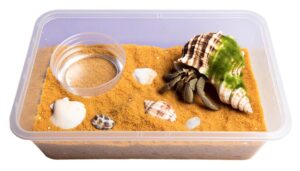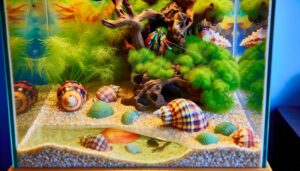Do Hermit Crabs Like Music in Their Environment?
Hermit crabs do enjoy company and exhibit complex social behavior. They communicate through shell rapping and antennae contact, guaranteeing resource allocation and survival.
In captivity, they show more active behaviors like climbing and foraging when kept with companions. Social interactions reduce stress levels and promote mental stimulation, enhancing their quality of life.
However, signs of social stress, like shell fights and prolonged inactivity, indicate that a carefully crafted habitat is essential. By mimicking natural conditions and encouraging social enrichment, you ensure your hermit crabs remain healthy and active.
Want to understand the best ways to set up their environment?

Key Takeaways
- Hermit crabs exhibit enhanced physical health and social interactions when kept in groups.
- They show more active behaviors like climbing and foraging when they have companionship.
- Social interactions in hermit crabs reduce stress levels and lower stress hormones.
- Hermit crabs living in groups have a longer lifespan and better quality of life.
- They communicate and engage in shell exchanges, benefiting from mutual cooperation and reduced conflict.
Natural Habitat and Behavior
Hermit crabs, mainly found in coastal shorelines and tidal pools, exhibit behaviors highly suited to their dynamic environments. You'll observe them scavenging for food, using their sharp sense of smell to locate decaying plant matter and small organisms.
These crabs are skilled at finding and inhabiting empty shells, which they use for protection against predators. This behavior highlights their impressive problem-solving abilities and resourcefulness. Hermit crabs also demonstrate a remarkable capacity for environmental adaptation, often migrating with the tides to avoid desiccation and extreme temperatures.
Their behavioral patterns, such as burrowing to escape the heat or climbing to avoid rising waters, are essential for their survival. Understanding these behaviors can guide you in creating ideal care conditions for these captivating creatures.
Social Structure in the Wild
In examining hermit crabs' social structure in the wild, you'll observe that they exhibit complex group living dynamics characterized by a hierarchical social order.
Research indicates that these crabs communicate and interact through specific behaviors, such as shell rapping and antennae contact.
This structured social interaction guarantees resource allocation and enhances survival rates within their communities.
Group Living Dynamics
Observational studies indicate that hermit crabs exhibit complex social behaviors that facilitate group living dynamics in their natural habitats.
You'll notice that hermit crabs often congregate in large clusters, which suggests a preference for social interaction. These clusters aren't random; they're strategic for enhancing survival. By banding together, hermit crabs can better locate food sources and protect against predators.
They also engage in shell exchanges, a behavior where individuals trade up for better-fitting shells. This mutual benefit reduces the risk of shell fights and injuries.
Additionally, their social cues and chemical signaling help coordinate group movements and activities. Understanding these dynamics can enable you to create environments that mimic their natural settings, promoting their well-being and social health.
Hierarchical Social Order
You'll often find that hierarchical social order among hermit crabs plays an important role in maintaining group stability and resource allocation in the wild. In their natural habitats, hermit crabs exhibit structured social hierarchies that promote efficient use of resources and minimize conflict.
This social order is evidenced by:
- Shell Selection: Dominant crabs claim superior shells, while subordinates wait for vacancies.
- Feeding Hierarchy: Higher-ranked crabs access food sources first.
- Defense Mechanisms: Group members collectively deter predators, driven by the hierarchy.
- Reproductive Success: Dominant males have enhanced mating opportunities.
These behaviors indicate a complex social structure that supports the well-being of the group, aligning with principles of cooperative living and effective resource distribution. This structure ultimately facilitates a more harmonious coexistence.
Communication and Interaction
Hermit crabs communicate and interact through a variety of behaviors. These behaviors include antennal contact, shell rapping, and body posturing. These interactions are crucial for maintaining their social structure in the wild.
You'll notice that antennal contact involves crabs touching each other's antennae. This form of tactile communication helps them recognize and establish social bonds.
Shell rapping is another behavior where one crab taps another's shell. This action often signifies competition or negotiation for resources like shells.
Body posturing is also significant among hermit crabs. This behavior includes raising claws or extending legs, serving as a form of visual signaling to assert dominance or submission.
These interactions are essential for the crabs' survival. They ensure efficient resource allocation and minimize conflict, thereby fostering a cooperative community structure among hermit crabs.
Hermit Crabs in Captivity
In captivity, proper environmental conditions are essential for ensuring the health and social well-being of hermit crabs. You should provide a habitat that mimics their natural environment to promote their overall welfare.
Key factors include:
- Temperature and Humidity: Maintain temperatures between 75-85°F and humidity levels around 70-80%.
- Substrate: Use sand or coconut fiber deep enough for burrowing, at least 3-4 inches.
- Diet: Offer a varied diet including fresh fruits, vegetables, and protein sources.
- Enrichment: Provide climbing structures, extra shells, and hiding spots to stimulate natural behaviors.
Benefits of Companionship
Research indicates that providing companionship for hermit crabs can enhance their physical health and social interactions. When you introduce multiple hermit crabs into the same habitat, you're likely to observe more active behaviors such as climbing and foraging. These activities not only keep their muscles strong but also reduce stress.
Studies show that hermit crabs housed with companions exhibit lower levels of stress hormones, promoting overall well-being. Social interactions, such as shell exchanges and communal digging, are essential for their mental stimulation. By creating a community, you're fostering an environment that mimics their natural habitat, leading to healthier, more vibrant hermit crabs.
Your efforts in doing so directly contribute to their longevity and quality of life.
Signs of Social Stress
When hermit crabs experience social stress, you'll notice an increase in shell fights as they compete for resources.
Additionally, isolated behavior becomes evident, with crabs withdrawing into their shells more frequently.
Such stress also correlates with decreased activity levels, indicating a significant impact on their overall well-being.
Shell Fights Increase
As social interactions among hermit crabs intensify, an observable rise in shell fights highlights their susceptibility to social stress. When hermit crabs experience overcrowding or limited resources, they engage in aggressive behaviors to secure better shells. This behavior underscores the importance of understanding social stress indicators.
Factors leading to increased shell fights include:
- Overcrowding: High population density escalates competition.
- Limited Shell Availability: Scarcity of suitable shells forces crabs into conflict.
- Size Discrepancies: Larger crabs often displace smaller ones, causing stress.
- Environmental Changes: Alterations in habitat can disrupt social hierarchies.
Careful observation and management of these factors can mitigate social stress, ensuring a healthier environment for hermit crabs. Recognizing and addressing these signs can enhance their well-being and promote harmonious interactions.
Isolation Behaviors Observed
Observing hermit crabs, you'll notice that social stress can also manifest in isolation behaviors, where individuals intentionally withdraw from group activities. These behaviors include hiding in shells for extended periods and avoiding communal feeding zones.
Scientifically, these signs suggest a disruption in their social dynamics, potentially caused by overcrowding or aggression from dominant crabs. Studies have shown that isolated crabs exhibit increased grooming, a behavior linked to stress relief. They might also become less responsive to environmental stimuli, indicating psychological stress.
Decreased Activity Levels
Markedly decreased activity levels in hermit crabs can be a clear indicator of social stress within their environment. When you observe your hermit crabs, look for these specific signs:
- Reduced Foraging: Your hermit crabs may spend less time searching for food, indicating stress.
- Lack of Shell Exchange: A hermit crab that doesn't actively seek new shells may be feeling the effects of social isolation.
- Decreased Interactions: Minimal interaction with other crabs can signify that they're experiencing social stress.
- Prolonged Inactivity: Extended periods of immobility may point to an unhealthy environment.
Monitoring these behaviors can help you determine if your hermit crabs are experiencing social stress, allowing you to take steps to enhance their well-being.
Creating a Social Environment
Creating a social environment for hermit crabs involves carefully mimicking their natural habitats to encourage interaction and reduce stress. Start by providing ample hiding spots and climbing structures, which replicate their coastal ecosystems. Use a mix of sand and coconut fiber for substrate, maintaining humidity levels around 70-80%.
Temperature should be kept between 75-85°F to ensure peak activity. Introduce multiple shells of varying sizes to prevent shell fights, promoting peaceful cohabitation. Studies show that hermit crabs are more active and exhibit less aggression in well-structured environments.
Regularly monitor their behavior and health, adjusting conditions as needed. By meticulously crafting a naturalistic habitat, you'll foster a thriving, socially enriched hermit crab community.
Conclusion
So, do hermit crabs really enjoy company? The evidence suggests they do. In the wild, they're rarely alone, and social behaviors are well-documented.
In captivity, companionship can reduce stress and promote healthier behaviors. But here's the catch—without proper conditions, overcrowding can lead to aggression and stress. Are you providing the right environment?
The delicate balance between social needs and space may just determine your hermit crabs' well-being. Are you up to the challenge?






